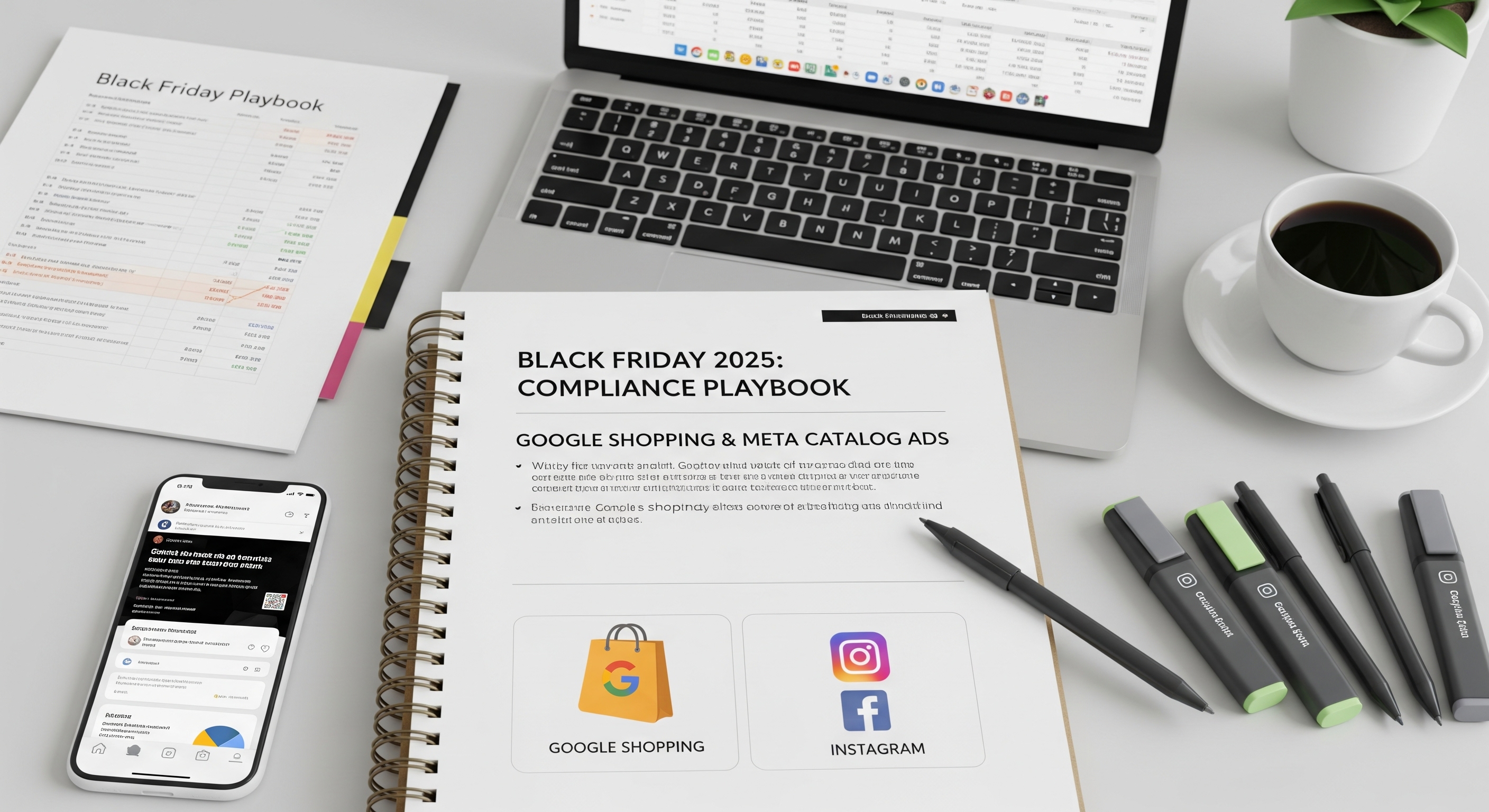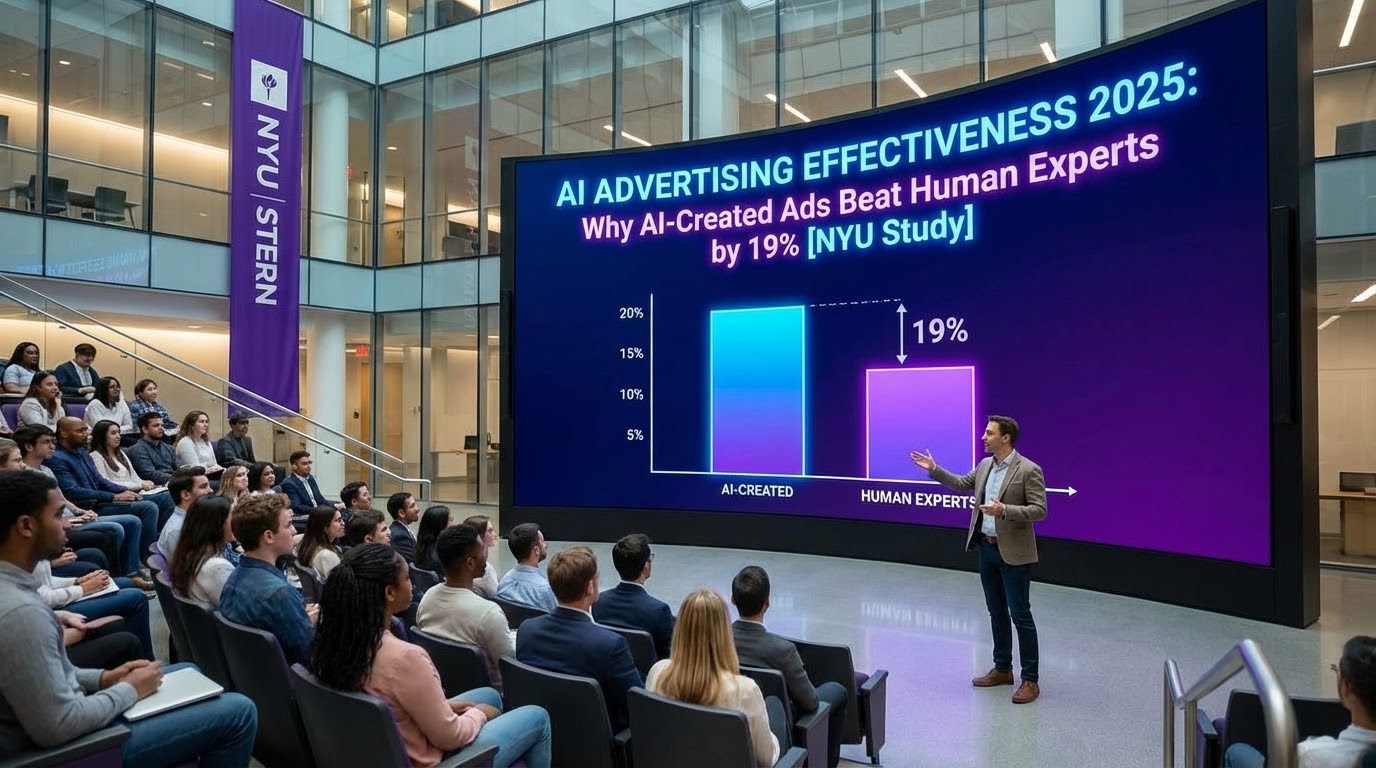
Black Friday 2025: the compliance guide for your Google Shopping and Meta Catalog Ads campaigns
Protect your holiday revenue by mastering feed compliance, AI‑powered visuals, and creative diversity
Black Friday and the holiday season are the most profitable days of the year, but also the riskiest for advertisers. Billions of ad impressions compete for consumer attention, and one mistake in your product data or creative strategy can derail performance. Google Merchant Center warns that missing or incorrect product information prevents ads from serving and that non‑compliant items can trigger account‑level warnings. Marketing experts note that failure to meet the Merchant Center guidelines can result in suspension, reduced visibility, and reputational harm.
On the social side, Meta’s new Andromeda retrieval engine rewrites how ads are selected and delivered. Instead of fine‑tuned audience targeting, success now depends on the breadth and quality of your creatives. Meta’s guidance emphasises that creative diversification is now the best lever for finding relevant audiences and that Andromeda rewards advertisers who supply varied concepts, format, and personas.
This guide distills those changes into a practical compliance playbook. Follow these steps to safeguard your budgets across Google Shopping and Meta Ads while scaling profitable growth.
Why feed compliance is your new growth lever
Non‑compliance suspends your listings and kills revenue
Google Merchant Center uses automated systems to enforce local regulations. If a product is missing a legally required attribute or uses incorrect values, Merchant Center marks it as non‑compliant. Warnings appear under the Needs attention tab, and unresolved issues can lead to suspension.
The impact goes beyond temporary disapproval:
- Lost visibility – Non‑compliant items are removed from Shopping ads and free listings, meaning your best‑selling SKUs vanish when customers are most active.
- Performance distortion – Missing products skew your campaign data, making it impossible to evaluate true performance or bid efficiently.
- Reputation damage – Customers may see outdated prices, missing variants, or disallowed imagery, eroding trust in your brand.
Feed data quality powers AI‑generated visuals.
Google’s latest AI tools generate contextual lifestyle images that showcase products in realistic environments. These visuals boost message recall and conversion rates; ads featuring contextual imagery deliver 2.2× better recall and 10% higher conversion rates than plain product photos. However, the quality of these AI images depends entirely on structured product data. The AI analyses your attributes to generate scenes; incomplete or incorrectly formatted data results in generic or misaligned visuals.
Google’s product specification introduces a new optional attribute, lifestyle_image_link, that lets you submit a lifestyle image URL for each product. When using generative AI tools (like Product Studio) to create these images, you must preserve IPTC metadata indicating that the image was AI‑generated. Failing to include the metadata may lead to policy violations and disapprovals.
Continuous feed audits prevent surprises.
The new Issue Details Page (IDP) in Merchant Center consolidates product‑level problems, recommended actions, and affected SKUs. Use this dashboard to prioritise fixes before peak traffic. Conduct regular feed audits:
- Full‑feed checks – Audit all products for required attributes (ID, title, price, availability, GTIN).
- Lifestyle image compliance – Ensure AI‑generated lifestyle images have preserved metadata and are linked via lifestyle_image_link.
- Policy review – Remove promotional overlays, watermarks, or prohibited content; update tax and shipping details to reflect your latest policies.
A structured, accurate feed not only keeps your listings live but also unlocks the full potential of AI‑driven creative and ranking systems.
Lifestyle images and multimodal assets: the new creative frontier
Contextual visuals drive engagement
Consumers scroll fast, and you have roughly 1.7 seconds to capture their attention. High‑quality visuals establish credibility and communicate value. Google’s generative AI now produces lifestyle images featuring human subjects and realistic scenes; this technology allows advertisers to move beyond catalog shots and create audience‑specific visuals. Major benefits include:
- Contextually relevant scenes – The AI analyses product attributes and generates usage scenarios that resonate with shoppers, increasing ad relevance.
- Unique asset creation – AI‑generated images are based on specific product data, differentiating your ads from competitors who rely on stock photos.
- Faster production – Traditional photography can take weeks; generative AI delivers final assets in minutes.
Feed quality dictates creative quality.
The AI’s output depends entirely on the richness of your product feed. Structured titles, attribute‑rich descriptions and complete technical specifications enable the system to generate accurate, context‑specific visuals. For example, a well‑structured product called “Women’s waterproof hiking boot” with detailed material and usage attributes will produce a very different lifestyle image than a generic “Women’s boot” listing.
Prepare for a multimodal campaign.
Multi‑channel advertising increasingly requires a range of multimodal assets: images, videos, rich text, and lifestyle photos. Dataïads’ Smart Asset and Feed Enrich solutions help merchants generate visuals, videos, and text directly from product data. By enriching feeds with additional attributes and images, you create the foundation for Performance Max and Demand Gen campaigns, which rely on varied creative assets. Remember: always include separate fields for standard images (image_link), additional angles (additional_image_link) and lifestyle visuals (lifestyle_image_link).
Meta Andromeda: creative quality is the new targeting
Understanding Meta’s new retrieval engine
Meta’s Andromeda update replaces rule‑based retrieval with deep neural networks that analyse user behaviour, eligible ads, and creative options in real time. Key features include:
- More intelligent ad retrieval – Hierarchical indexing and powerful hardware scan tens of millions of ads to serve the right message at the right moment.
- Creative‑first optimisation – Personalisation now depends on your ad’s visuals, message, and format; diverse creatives drive better performance.
- Simplified campaign structure – Single, broad targeting often outperforms complex ad sets, allowing Andromeda to optimise delivery using live signals.
- Data‑driven improvement – High‑quality conversion data and budget allocation directly influence algorithmic learning.
Creative diversification replaces micro‑targeting
Meta advises advertisers to shift from niche targeting to creative diversification. This means providing a range of ads that differ meaningfully in concept, format, and persona. Andromeda is designed to handle the explosion of creative options and match the right message to the right user. Advertisers should:
- Vary concepts – Problem/solution, testimonials, lifestyle narratives, and product demos.
- Mix formats: short videos, long videos, static images, carousels, collections.
- Address multiple personas – Segment ads by user intent or persona rather than by demographic micro‑targets.
Andromeda rewards campaigns that offer more creative options; creative fatigue sets in faster when the system tests more ads simultaneously. Frequent creative iteration keeps engagement high and ensures that the retrieval engine continually learns from new signals. Dataïads’ Smart Creative helps produce thousands of catalog ads and lifestyle variations at scale, making it easier to feed Andromeda with fresh content.
We wrote a deep dive into Meta Andromeda: Andromeda: the end of targeting, the start of the creative era — what online retailers need to change in 2025
Dataïads compliance playbook for Black Friday
Running successful Shopping and Meta Ads campaigns during Black Friday requires proactive compliance and continuous creative optimisation. Use this checklist to stay ahead:
- Define policy rules – Document prohibited content (promotional overlays, missing attributes), allowable AI‑generated images, and required metadata tags. Set clear consequences for repeated violations.
- Audit feeds weekly – Check all SKUs for missing attributes, inconsistent pricing, incorrect availability, and updated tax/shipping information. Use the Merchant Center IDP to prioritise fixes.
- Enrich data for AI – Add rich attributes (materials, usage context, occasions) to enable accurate lifestyle image generation. Provide separate lifestyle images via the lifestyle_image_link attribute.
- Diversify creatives – Generate a breadth of concepts and formats for Meta. Use Dataïads’ Smart Creative to create varied catalog ads from the same feed, ensuring each ad speaks to different personas.
- Simplify campaigns – Consolidate ad sets and use broad targeting. Let Andromeda determine the best creative/placement combination.
- Collect clean data – Implement server‑side tracking or conversion API solutions to ensure complete event data for Meta. Missing events limit Andromeda’s learning ability.
- Monitor creative fatigue – Rotate new ads frequently; track performance to identify declining creatives and refresh them.
- Document evidence – Save screenshots of disapproved items, error messages, and flagged creatives. A clear trail helps resolve compliance disputes quickly.
Minimum always‑on monitoring profile
How Dataïads automates compliance and creative excellence
Manual monitoring doesn’t scale when hundreds of SKUs and creative variants are live. Dataïads offers an end‑to‑end solution:
- Feed Enrich – Enriches product feeds with AI‑generated attributes, images and lifestyle visuals to meet platform‑specific requirements. Real‑time synchronisation ensures your feed stays compliant across Google and Meta.
- Smart Creative – Converts product data into high‑performance catalog ads, lifestyle images, and videos at scale. Dynamic templates connect to your feed so you can test variations quickly without manual design.
- Smart Asset – A multimodal AI studio that transforms your product feed into endless content (images, videos, text), ready for activation across channels.
- Smart Landing Page – Automatically creates and tests landing pages to ensure that post‑click experiences match pre‑click promises and comply with platform policies.
By automating feed enrichment, creative production, and post‑click optimisation, Dataïads helps you deliver complete, compliant product data and a steady stream of diverse creatives. This synergy maximises your chances of winning in both Google Shopping and the Andromeda era on Meta.
Conclusion
Black Friday rewards speed, relevance, and creativity – but punishes blind spots. When product data is incomplete or non‑compliant, your ads disappear, and when creative diversity is lacking, Meta’s Andromeda defaults to generic options. The brands that win will proactively audit their feeds, embrace AI‑generated lifestyle images, and invest in creative diversity.
Dataïads stands at the intersection of feed intelligence and multimodal creative production. By following this compliance playbook and leveraging Dataïads’ automation capabilities, you can enter the holiday season confident that your Shopping and Meta Ads campaigns are both compliant and compelling. Test Dataïads’ platform today to turn Black Friday risks into growth opportunities.
Continue reading

Agentic AI and New Shopping Dynamics: Understanding the Rise of AI-Driven Shopping in 2026

AI Advertising Effectiveness 2025: Why AI-Created Ads Beat Human Experts by 19% [NYU x Emory Study]

Nano Banana Pro: Full analysis of the latest Google 2025 Image Generation Model
.svg)







